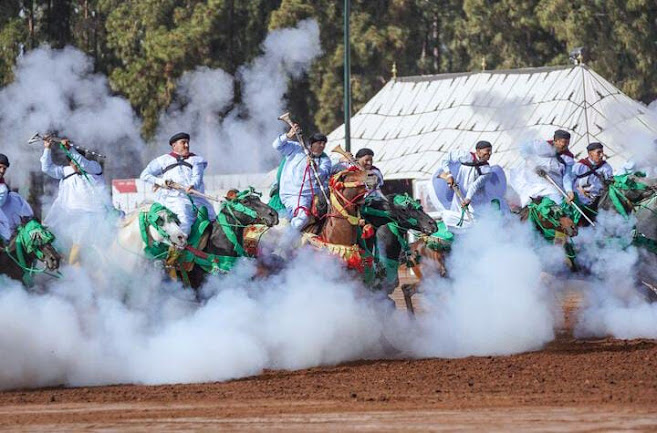What is Tbourida?
Fantasia, also known as Tbourida, is one of Morocco's oldest and most celebrated equestrian traditions, embodying dramatic scenes that mimic military raids and showcasing the bravery and skill of Moroccan horsemen. Tbourida performances are held across Morocco, from the desert regions to the Amazigh areas, drawing large audiences from both within and outside the country. This ancient art dates back to the 15th century and has been passed down through generations, preserving its deep spiritual significance, which reflects the Moroccans' strong connection to their nomadic heritage and love for horses, regarded as sacred animals.
Tbourida is featured in numerous festive occasions in Morocco, including seasonal festivals, agricultural celebrations, as well as family and national holidays, making it an integral part of the Moroccan cultural identity and an eagerly anticipated event for spectators. Known as "Fantasia" in Western circles, Tbourida continues to capture international admiration and appeal.
Origins and History of Fantasia :
The origins of the art of Tbourida date back to the 15th century, where it emerged as part of Moroccan folklore and served as a means of defending against enemies and invaders seeking to control Moroccan lands. These performances, which blend horsemanship and rifle use, became symbols of bravery and honor. Warriors would form tight rows on horseback, holding their rifles, and perform synchronized movements that showcased their skill and strength in facing external challenges.
Today, Tbourida is an inseparable part of Morocco's rich heritage and continues to capture the admiration of Moroccans from all walks of life, past and present. Hardly any national or family celebration goes by without a Tbourida performance, as this art is deeply intertwined with Moroccan customs and traditions. These events are popular celebrations that draw thousands of spectators; the arena comes alive with chants, songs, and spirited cheers that honor gunpowder and the rifle, both of which are essential elements of this unique performance.
Tbourida showcases the talents of the most skilled riders, who mount beautifully trained horses specifically bred for this art, executing precise, coordinated movements that demand both courage and accuracy. Mastery of this art is a symbol of prestige and high standing, as those who practice Tbourida hold a noble reputation and are regarded with great respect within their communities, seen as guardians of tradition and esteemed symbols of Moroccan authenticity.
Rules and Styles of Tbourida:
Tbourida, or Fantasia, is a traditional Moroccan equestrian art that reflects the country’s rich cultural heritage. Here are the essential rules and styles that characterize Tbourida performances:
Rules of Tbourida
- Coordination:
- Firearms Use:
- Traditional Attire:
- Trained Horses:
- Accompanying Songs:
- Dynamic Movements:
- Traditional Greetings:
Styles of Tbourida
- Interactive Performances:
- Historical Narration:
- Skill Display:
- Role Distribution:
- Musical Synchronization:
- Movements are choreographed to musical rhythms, adding artistic flair.
Tbourida remains a vibrant cultural experience that captivates both local and international audiences while preserving Moroccan traditions.
Types and Styles of Traditional Attire for the Fantasia:
The attire worn during the Fantasia is distinctive and uniform among all riders, reflecting a rich cultural heritage. Each horseman typically wears a traditional white djellaba, layered over a garment known as farjiya or tchamire, paired with wide, flowing Arabic trousers that are also white. Over this ensemble, they don a *burnous*, made of light white fabric.
All riders wear a white turban, often adorned with red silk cords. Additionally, a rider may carry a kumiya (a traditional dagger), a khankar (a type of belt), or a shkara (a small bag) with a red mjdol draped over their shoulder. The boots are made of lightweight leather, reaching just below the knee, with spurs attached to the front to help guide the horse during performances, which are known as *tamak*. This traditional attire not only serves a practical purpose but also symbolizes the pride and artistry associated with the Fantasia.
Final Thoughts:
In closing, our discussion about the **Tbourida** reveals that it is not merely a performance art but a vibrant experience that reflects Morocco's rich heritage and history. Tbourida embodies national pride and combines artistic beauty with the spirit of horsemanship, making it an integral part of Morocco's cultural identity.
Discovering this authentic art form invites visitors to explore the magic and cultural richness of Morocco. We encourage tourists and adventurers to visit Morocco and participate in Tbourida events, where they can enjoy breathtaking displays and interact with the riders and their horses, experiencing the festive atmosphere that showcases Moroccan pride and traditions. Let us continue to celebrate Tbourida as a symbol of the fantasy that deserves to be told and cherished at all times, and together, let’s contribute to enhancing tourism and raising awareness about this rich heritage.
